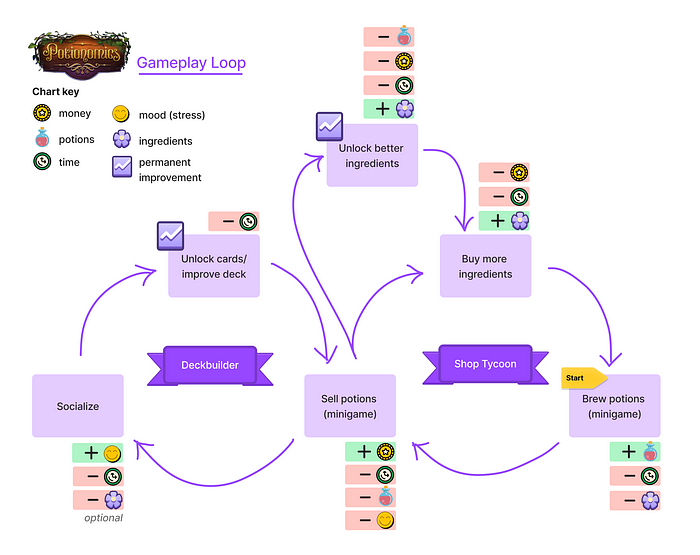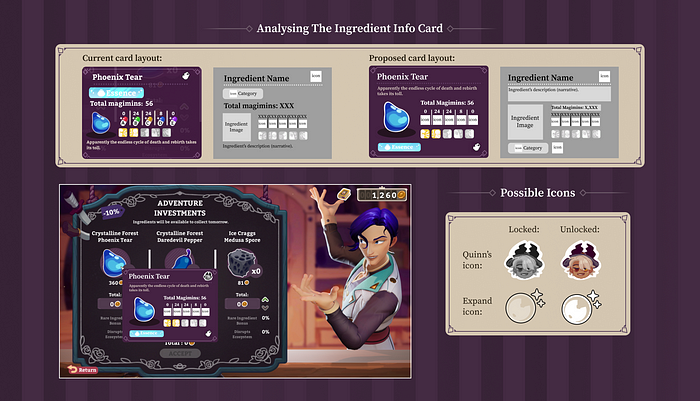

Game UX Analysis: Potionomics
source link: https://uxplanet.org/game-ux-analysis-potionomics-8e51187ec69c
Go to the source link to view the article. You can view the picture content, updated content and better typesetting reading experience. If the link is broken, please click the button below to view the snapshot at that time.

Game UX Analysis: Potionomics

Potionomics, a fantasy potion-brewing tycoon, came out on Steam in October and I’ve been hooked. Players take on the role of Sylvia, a recent graduate who suddenly inherits her uncle’s remote potion shop, only to get there and discover she’s also inherited his huge debt with just 50 days to pay it all off. Blending a lot of mechanics into one task-managing balancing act, Potionomics can be as rewarding as it is stressful (in the best way).
Online sentiment for Potionomics is positive, but a lot of reviewers ask for “quality of life” improvements to better support its time-sensitive juggling act. So in this UX analysis I’m going to break down the core features of the game in order to identify which “quality of life” improvements are most likely to have the highest impact.
Understanding the Gameplay

The key to success in this game is planning Sylvia’s schedule in order to get the most out of her day, and by knock-on effect her entire week.
The full campaign of Potionomics is split into 5 ‘weeks’ (weeks are are 10 days each in this universe), during which our heroine Sylvia will work her butt off running the shop. By the end of each week she needs to have prepared 3 potions for a potion-brewing competition. That’s 5 competitions in total.
Each day is broken up into 6 “time-slots”, and everything Sylvia needs to do will take time. When it comes to time management, there are two types of tasks: Passive and Active. Passive tasks (such as brewing potions) take time to complete in the background, they’re a “set and forget” type of deal. Active tasks (such as opening the shop) require Sylvia’s full attention.
In practice this means that in order to be efficient, players will want to start a passive task before an active task. A real-life example of this is when a cookie recipe has you preheat the oven (passive) before you start making the batter (active). Now that we understand this, we understand Potionomics’ scarcest resource; time.
Detailing The Gameloop

Gameplay loops let you identify steps that are of high importance for the player
Here we see two loops emerge which run in parallel for the player.
Shop Tycoon Loop:
- Players brew potions. This costs ingredients, and time (passive) in varying amounts.
- Sell potions for profit in the haggling mini-game, this costs 2 time-slots (active).
- Purchase more ingredients with the money they’ve made. This also costs 1 time-slot (active), for travel.
- Eventually, unlock better/new ingredients using two main methods. Both cost time (passive) in varying amounts.
Deckbuilder Loop:
- Socialise with other characters, or give gifts (ingredients) to improve relationships. This costs 1 time-slot (active), for travel. Plus additional time for the social activities (active) in varying amounts.
- After gaining a set (but unsurfaced) amount of relationship points, the player will unlock the option to “Rank up” their relationship.
- Ranking up a relationship will often (but not always) unlock a new card from that character’s deck. This costs 1 time-slot (active).
- The player can then use the new card in their deck, and with the right strategy, improve their profit margin.
Note: I’ve intentionally left out the shop upgrades and customisation in order to focus on the core gameplay.
Potion Brewing and The Opportunities it Reveals

Mixing ingredients for a potion and previewing the outcome
One of the most frequent hurdles that the player will face is not having the right ingredients to brew the potion they need. The players are most likely to discover this when in the Potion Brewing screen.
Potion Brewing is one of the most common and (in my opinion) most fun activities in the game. Here the player can preview the outcome of any potion before committing, so it becomes really easy to spend a lot of time tinkering with ingredient combinations in order to optimise the brew.
Often during this process the player will realise (or begrudgingly accept) that they don’t have the ingredients necessary, and they’ll either need to purchase more from Quinn’s shop or try to discover brand new ones. How they solve it depends on each case, and can branch into a few directions that each require some planning ahead.
User-flow: Getting ingredients needed for a potion

User-flows visualise a player’s pathway through a feature , and help identify opportunities
What Are The ‘Cheapest’ Opportunities Here?
- Buying ingredients at Quinn’s shop is slow because there’s no filter.
- As players progress, they lose track of which ingredients they’ve “unlocked” for Quinn’s shop.
- Between sessions, players can lose track of of the status of their hero adventures and investments.
Proposed “Quality of Life” Improvements
Like when managing Sylvia’s time in Potionomics, in the world of gamedev every interface change comes at a cost. Budget and time are the obvious ones, but there’s also a balancing act when it comes to the vision of the game, whether artistic or otherwise. One of the challenges I find the most satisfying UX designer is identifying changes that have the best impact:cost ratio. This is why I’ve chosen the suggested improvements below.
Opportunity: Buying ingredients at Quinn’s shop is slow because there’s no filter.

Proposal: Reuse the filter from the potion brewing screen.
Ok sorry, this one is a bit dry. But there are so many requests online for this that I thought I should just get it out of the way. And with over 100 ingredients across 12+ shop tabs, it’s no surprise players want this. A stretch goal would be to add an option to sort by total magimins or cost.
Opportunity: As players progress, they lose track of which ingredients they’ve “unlocked” for Quinn’s shop.

Proposal: Add a locked/unlocked icon to ingredient info cards.
When the player discovers new ingredients, they have the option to donate it to Quinn in order to “unlock” that ingredient for Quinn’s shop. The pain-point here is that there’s no real way for the player to see what they’ve already donated without visiting Quinn. Adding a “locked” or “unlocked” icon to the ingredient info cards will let players make better adventure investment choices, and help them keep track elsewhere.
For this change I’ve mocked up two icon options: I think the Quinn icon is the most logical, but the expand icon is a compromise offer for visual consistency. I’ve also included a small reshuffle of the card information but honestly that wasn’t as important, I just had the urge to tidy it a bit.
Opportunity: Between sessions, players can lose track of the status of their hero adventures and investments.

Proposal: Introduce two new map pin states. One: A hero is unavailable (with a timer), and two: a hero has loot to collect.
When players Hire Heroes for an adventure it can take the hero anywhere between 2–6 time-slots to complete. In the current version of this flow, when a hero is out on their adventure their map pin simply vanishes. But what happens when the player ends their session and doesn’t play again for a few days? How do they keep track of what’s waiting for them?
This is a case of when it’s important to consider the player’s behaviour outside the game as well. Adding these two new pin states will help the player keep up their momentum across sessions, and help them plan their tasks while waiting for a hero to return.
Recommend
About Joyk
Aggregate valuable and interesting links.
Joyk means Joy of geeK